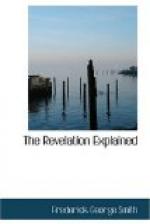In the first place, if this does not describe the actual coming of Christ, then his second coming is nowhere described in the Revelation. That so great an event should merely be alluded to in a few places and nowhere symbolically described seems incredible. At the judgment scene brought to view in the following chapter the presence of Christ is assumed, but it is not stated. Again, there are no victories of love and mercy described at all in the vision before us; but, on the contrary, it is a scene of fearful judgment—a terrible treading of “the winepress of the fierceness and wrath of Almighty God,” the complete overthrow of every opposing power; while the beast and the false prophet are represented as taken and cast alive into a lake of fire burning with brimstone. Surely, this is not the work of the church of God. But let it be remembered especially that this last event takes place under the seventh plague, which is the “filling up” of the wrath of God, and that Christ previously announced under the sixth vial, “Behold, I come as a thief.” Christ comes in reality when this seventh plague occurs. To represent the glorious triumphs of Christianity by the mission of the church, the gospel and the Holy Spirit, under the symbol of Christ, going forth to judge, to make war, and to tread the winepress of God’s wrath, is at war with every principle of symbolic language.
But can this vision of Christ upon a white horse denote a mere providential superintendence, such as Christ constantly exercises over the church and its spiritual affairs on earth? Certainly not by any principle of symbolic language. Throughout the whole prophecy thus far we have seen that whenever any symbolic agent is brought upon the panorama, whether horseman, or beasts, or locusts, or harlot, or whatever else, it always denotes some corresponding agents appearing on earth and beginning their appropriate work. The symbolic agent is real. But here is a symbolic appearance of Christ. By what law could such a symbolic appearance represent merely a providential superintendence? And if his appearance was necessary in this case, why was it not necessary in every event, to show that it was done under his direction? Again, if this symbolic appearance of Christ is not his real appearance, how can we tell that there is any reality in the appearance of the horsemen of the first four seals, the ten-horned beast, or the harlot woman? What right have we to remove one agent




